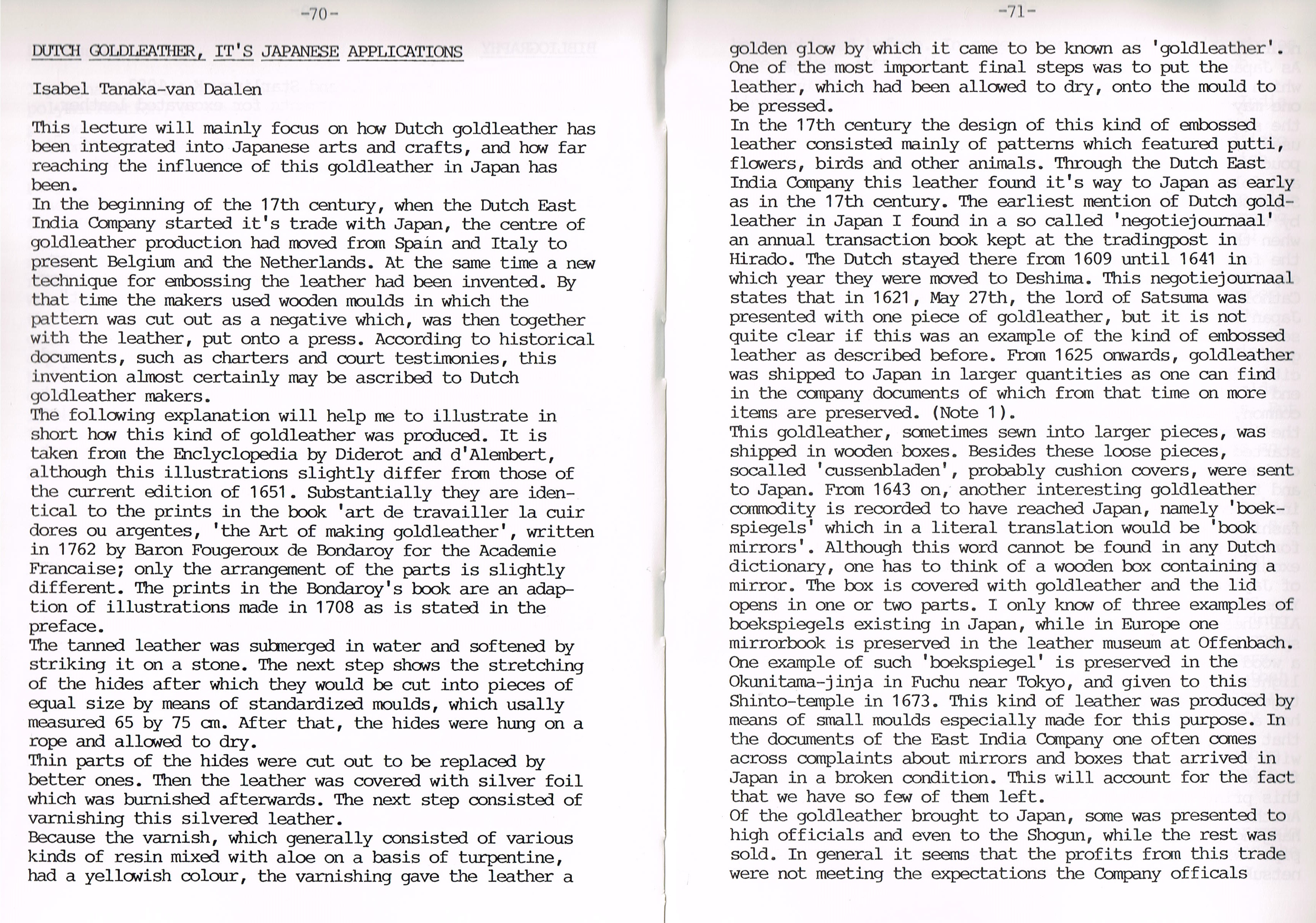CCI20140507�38

-70-
DUTCH GOLDLEATHER, IT'S JAPANESE APPLICATIONS Isabel Tanaka-van Daalen
This lecture will mainly focus on how Dutch goldleather has been integrated into Japanese arts and crafts, and how far reaching the influence of t±iis goldleather in Japan has been.
In the beginning of the 17th century, when the Dutch East India Company started it's trade with Japan, the centre of goldleather production had moved from Spain and Italy to present Belgium and the Netherlands. At the same time a new techniąue for embossing the leather had been invented. By that time the makers used wooden moulds in which the pattem was cut out as a negative which, was then together with the leather, put onto a press. According to historical documents, such as charters and court testimonies, this invention almost certainly may be ascribed to Dutch goldleather makers.
The following explanation will help me to illustrate in short how this kind of goldleather was produced. It is taken from the Enclyclopedia by Diderot and d'Alembert, although this illustrations slightly differ from those of the current edition of 1651 . Substantially they are iden-tical to the prints in the book 'art de travailler la cuir dores ou argentes, 'the Art of making goldleather', written in 1762 by Baron Fougeroux de Bondaroy for the Academie Francaise; only the arrangement of the parts is slightly different. The prints in the Bondaroy's book are an adap-tion of illustrations madę in 1708 as is stated in the preface.
The tanned leather was submerged in water and softened by striking it on a stone. The next step shcws the stretching of the hides after which they would be cut into pieces of egual size by means of standardized moulds, which usally measured 65 by 75 cm. After that, the hides were hung on a ropę and allowed to dry.
Thin parts of the hides were cut out to be replaced by better ones. Then the leather was covered with silver foil which was bumished afterwards. The next step consisted of vamishing this silvered leather.
Because the vamish, which generally consisted of various kinds of resin mixed with aloe on a basis of turpentine, had a yellowish colour, the yamishing gave the leather a golden glow by which it came to be kncwn as 'goldleather'. One of the most important finał steps was to put the leather, which had been allowed to dry, onto the mould to be pressed.
In the 17th century the design of this kind of etrtbossed leather consisted mainly of pattems which featured putti, flowers, birds and other animals. Through the Dutch East India Company this leather found it's way to Japan as early as in the 17th century. The earliest mention of Dutch goldleather in Japan I found in a so called ' negotiej oumaal1 an annual transaction book kept at the tradingpost in Hirado. The Dutch stayed there fron 1609 until 1641 in which year they were moved to Deshima. This negotiej oumaal states that in 1621, May 27th, the lord of Satsuma was presented with one piece of goldleather, but it is not quite elear if this was an example of the kind of embossed leather as described before. Frań 1625 onwards, goldleather was shipped to Japan in larger ąuantities as one can find in the company documents of which from that time on morę items are preserved. (Notę 1 ).
This goldleather, sometimes sewn into larger pieces, was shipped in wooden boxes. Besides these loose pieces, socalled 'cussenbladen', probably cushion covers, were sent to Japan. Frcm 1643 on, another interesting goldleather commodity is recorded to have reached Japan, namely 'boek-spiegels' which in a literał translation would be 'book mirrors'. Although this word cannot be found in any Dutch dictionary, one has to think of a wooden box containing a mirror. The box is covered with goldleather and the lid opens in one or two parts. I only know of three examples of boekspiegels existing in Japan, while in Europę one mirrorbook is preserved in the leather museum at Offenbach. One example of such 'boekspiegel' is preserved in the Okunitama-jinja in Fuchu near Tokyo, and given to this Shinto-tempie in 1673. This kind of leather was produced by means of smali moulds especially madę for this purpose. In the documents of the East India Company one often comes across complaints about mirrors and boxes that arrived in Japan in a broken condition. This will account for the fact that we have so few of them left.
Of the goldleather brought to Japan, some was presented to high officials and even to the Shogun, while the rest was sold. In generał it seems that the profits from this trade were not meeting the expectations the Company officals
Wyszukiwarka
Podobne podstrony:
CCI20130126�006 RyC> ^3. ^ ęJj&dcJśr-w^it ćjyuztyiro — yL4sv-tnryoh . ćł}
CCI20100422�001 bmp Łkii ITFUB-it .
CCI20130725�068 70 5. Usuwanie związków fosforu ze ścieków5.2. Biologiczne usuwanie fosforu w wyniku
CCI20140403�19 70 Wytłaczanie Kolejna praca miała na celu zróżnicowanie błyszczącej powierzchni skór
CCI20140507�03 - 2 - workinggroups I have myself several times participated at meetings such as this
CCI20140528�37 70 Rozdział 3 Natura związków organicznych: alkany i cykloalkany Tabela 3.1 Struktu
00233 ?994b263585678f9e7929f08dc27281 235 Applications of the EWMA Closed-loop sigma (ar) is calcul
APPLICATION OF FLAYOUR COMPOUNDS IN FOOD Lecture: dr Aneta Jastrzębska Seminar: dr Aneta Jastrzębska
cp 55 will say—"It is unn.itur.il for mc to do this." Otbers will muttcr—“1 cannot brcathc
Zgodność Map i Navcore?5 The image is public, can put it in your forum unmodified, but not in the vi
CCF20090523�098 tif INDEKS NAZWISK A Antystenes 73 Arystoteles 32,43,70, 131 B Bach Johann Sebastian
2930 jobXapplication This kid will go far!! This is an actual job application that a 17-year-old boy
It works by capitalizing the very first letter in each sentence, and will then go on to transform th
więcej podobnych podstron